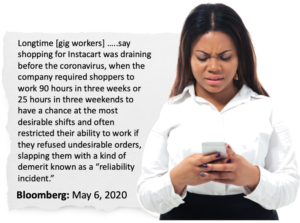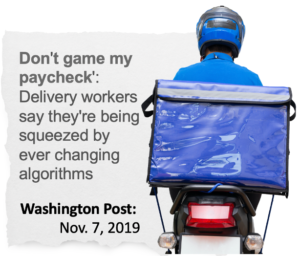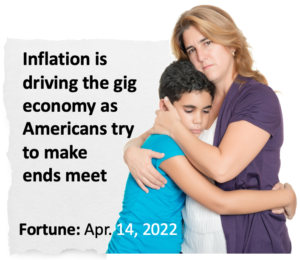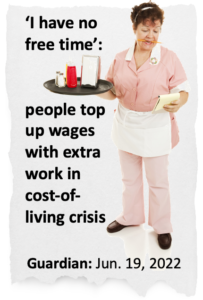 Untruths, pay cuts, uncertainty, control by algorithms; low-skill irregular work was bad before Covid-19. Then it got worse. Attempts to slow the trend aren’t working.
Untruths, pay cuts, uncertainty, control by algorithms; low-skill irregular work was bad before Covid-19. Then it got worse. Attempts to slow the trend aren’t working.
.
Three channels
Anyone doing uncertain, lower-skill, work will be using some combination of three ways of connecting to that work:
- Gig work platforms: There are thousands of them. They often have a lot of money, and receive a lot of attention. But a relatively small proportion of workers use them.
- Workforce scheduling: Even in 2017, 41% of hourly employees did not know next week’s hours. Around 59% of the workforce was hourly. So that was 24% of people in “jobs” wondering what next week’s hours or pay will look like. Those numbers have increased.
- Off-the-books: Many odd-hours of work are still found by word-of-mouth; going from café to bar to homeowner asking for ad hoc employment, probably for cash-in-hand. Up to 40% of Americans have earned in the shadow economy.
 It’s hard to see what’s going on with uncertain employment. Illegal, off-the-books, work is – of course – secretive. Employee scheduling is increasingy handled by software like Kronos Workforce Central 8. We don’t know how this sort of functionality to manage labor costs is being configured..
It’s hard to see what’s going on with uncertain employment. Illegal, off-the-books, work is – of course – secretive. Employee scheduling is increasingy handled by software like Kronos Workforce Central 8. We don’t know how this sort of functionality to manage labor costs is being configured..
 Eight problems
Eight problems
To lift-the-covers on the new world of de-regulated, tech-enabled, fluid workforces, we have to turn to publicly scrutinized gig work platforms. Uber is a widely used reference. Stratospheric valuations have made them a role model for thousands of start-up labor markets.
Here’s a roundup of challenges faced by anyone turning to Uber or its imitators as a channel to the labor market:
.
The high-profile issues
1) Classification: Are platform gig-workers employees of the platform? If they are only contractors, they are not entitled to genuine minimum wage or other protections. That’s great for platform profitability. California tried to enforce employee status with bill AB5. Gig work companies invested $205m to successfully overturn AB5 just 11 months later.
2) Benefits: If healthcare is provided by your employer, what happens to those with ever changing “employers”, each assuming benefits are someone else’s issue? The Affordable Care Act may no longer be the solution many hoped for. Absent widespread portable benefits, many gig workers live in terror of illness or accident.
.
Some less understood challenges
3) Limited exposure: Hindsight shows why irregulars have so little opportunity. Assume, to take one study, you sought work doing deliveries of food in Seattle in 2014. Potential buyers of your time were divided between incompatible, unstable, often confusing, fiercely competitive, labor platforms.
GrubHub, Postmates, Lish, Bitesquad, Eat24, Munchery, Peachd or Caviar all offered a chance to get work and build a track record. Where to go? It probably wouldn’t matter; a year later, it all changed. Amazon launched food delivery in Seattle then Uber muscled in. You couldn’t know where to seek work; platforms guard their sales data and plans. For real exposure to food delivery opportunity you needed to work across all these apps.
That can’t be done. Algorithms running Market A will downgrade you if not available for an assignment because you’re off doing a booking from Market B. You have to bet on a small number of markets at most. That’s like each job-seeker having to decide which 5%, or less, of employers would be the only ones whose openings they could ever view.
.
4) No progression: To improve your options you need to monitor not just platforms but sectors. As well as food in 2014, you may – for example – have been willing to deliver fuel to cars? There were marketplaces in multiple cities, each with funds to expand. So, would you have bet on the eventual success of Filld, Purple, FuelMe, Neighborhood Fuel, or Fueldrop? It likely wouldn’t have mattered, most of them failed.
And endless delivery runs may not be your life aspiration. There might be a local shortage of roofers, beauticians, tutors, or other gigs of interest. You don’t know. There is no market data to tell you. Compare that to public support and insights for job hunters.
.
 5) Overheads of getting work: Registering on gig work sites takes time, even though they may have no work for you. Waiting for messages, beating other work-seekers to respond to a gig, dropping everything to fulfill it even though it might be inadequately or unfairly described; these are all costs of gig working.
5) Overheads of getting work: Registering on gig work sites takes time, even though they may have no work for you. Waiting for messages, beating other work-seekers to respond to a gig, dropping everything to fulfill it even though it might be inadequately or unfairly described; these are all costs of gig working.
.
6) Market closures: Thousands of Americans were cleaning homes through Homejoy when investors lost interest and pulled the plug. Hirer relationships, track-records, and immediate work evaporated; leaving work-seekers, who may have strived to work well, to start again at the bottom of another market. A wave of shutterings followed: Prim and Washio (on-demand laundry) Rewinery (delivery of wine), Kitchit (meals cooked in your home), Cherry (car washes) and countless other markets claiming to empower independent workers. Exchanges coming perilously close to implosion strive to conceal it.
.
 7) Sudden pay cuts: Uber slashed workers’ rates while increasing its cut of fares in January 2016. Investor enthusiasm then boosted Uber’s funding, helping them develop a driverless future. Other platforms followed. See for instance reporting on Shipt, Lyft, Doordash, Instacart, AmazonFlex, or TaskRabbit. There would be outrage if job-holders had pay cuts like this.
7) Sudden pay cuts: Uber slashed workers’ rates while increasing its cut of fares in January 2016. Investor enthusiasm then boosted Uber’s funding, helping them develop a driverless future. Other platforms followed. See for instance reporting on Shipt, Lyft, Doordash, Instacart, AmazonFlex, or TaskRabbit. There would be outrage if job-holders had pay cuts like this.
.
8) Management by algorithms: Go through a bad patch in a job and you might get a warning, possibly some support in improving. Get poor ratings on a gig platform and work can just disappear. The black-box sophistication of these apps is driving buyer convenience and operator profitability, not a supportive labor market. Uber has produced code to mislead regulators, systematically encouraged drivers to keep working with diminished chance of pay, allegedly set out to knowingly undermine other marketplaces and encouraged what’s been called “modern share cropping”.
.
 Even before the pandemic, these problems were coming together in often desperate financial volatility. 92% of Americans would now rather just be financially stable than increase income.
Even before the pandemic, these problems were coming together in often desperate financial volatility. 92% of Americans would now rather just be financially stable than increase income.
The future of for-profit labor platforms? Anything could happen to this workforce. One development to watch: Uber’s on/off plans to extend their operations from ridesharing to all types of labor.There’s
Impact of the virus
 Each of these 8 issues worsened in the pandemic. A flood of often desperate work seekers has given the platforms even more power. Contracts have been tweaked. All sorts of businesses face uncertainty, with labor often their biggest cost. Wage theft in industries that make heavy use of irregular staff increased. Childcare remains a nightmare for so many parents who never know when they might get ad-hoc work.
Each of these 8 issues worsened in the pandemic. A flood of often desperate work seekers has given the platforms even more power. Contracts have been tweaked. All sorts of businesses face uncertainty, with labor often their biggest cost. Wage theft in industries that make heavy use of irregular staff increased. Childcare remains a nightmare for so many parents who never know when they might get ad-hoc work.
We don’t know how profit-extracting labor markets are adjusting their algorithms as demand for on-call workers increases. Nor do we know which might be close to bankruptcy. We do know their view of workers: Uber and Lyft were poised for California shutdown if courts had forced them to comply with new protections in 2020.
Uber and its competitors have no mandate, business case, or unique leverage to create a healthy labor market. That role traditionally belongs to public agencies like workforce boards. But many continue to focus on traditional models of employment, guided by performance metrics that offer little incentive to support irregulars. So, a variety of other organizations are struggling to tackle issues in the irregular labor market.
little .
Searching for solutions
California’s “AB5″ became law in January 2020, mandating protections like minimum wage for platform workers. It was contested bitterly and has been replaced by legislation drafted by gig work companies which creates – academics believe – an effective minimum wage of $5.64 an hour. But, even if AB5 had endured, it would only have solved some of the problems faced by some irregular workers. Elsewhere, courts have pressured gig work markets to recognize rights and collectivization for workers. The death of AB5 makes that a harder battle around the US.
 A few cities are outlawing ad-hoc staff scheduling. Elsewhere, states have pre-empted cities’ right to do this. Where flexible staff scheduling is curtailed, an array of platforms will send gig workers to replace employees.
A few cities are outlawing ad-hoc staff scheduling. Elsewhere, states have pre-empted cities’ right to do this. Where flexible staff scheduling is curtailed, an array of platforms will send gig workers to replace employees.
Entrepreneurs are – of course – addressing inefficiencies in gig work. Alfred tried to work across multiple markets to meet buyers’ needs. Peers set out to rank individual markets. Sherpashare merges individual’s data from all rideshare services. Credly and Traity tackle lack of co-ordinated track records. Stride healthcare, Honest Dollar and Policy Genius target financial products at “gig” workers. Marketplaces run as co-operatives are getting some traction. However, Juno provides a salutary lesson in how well-intentioned markets can fail to deliver.
 But administering new rules – or building add-ons – across unstable, ring fenced, regulator-resistant, platforms is challenging. Diverse initiatives are not slowing gig work.
But administering new rules – or building add-ons – across unstable, ring fenced, regulator-resistant, platforms is challenging. Diverse initiatives are not slowing gig work.
It could be we have a problem in the foundations. We suggest this sprawling part of the workforce needs access to robust, neutral, accountable, low overhead, data-sharing, protection enforcing, marketplaces before conditions can improve.
